Butterflies and Moths
Media

Species Types
Scientific Name
Polygonia comma
Description
The eastern comma is named for a small white mark on the underside of the hindwing. It flies spring through fall, and even in winter, on warm, sunny days.
Media
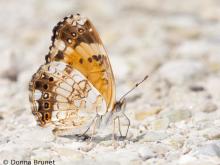
Species Types
Scientific Name
Chlosyne nycteis
Description
Black and orange above, paler below, the silvery checkerspot has a telltale wide white crescent in a brownish patch along the edge of the hindwing underside.
Media
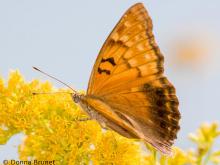
Species Types
Scientific Name
Asterocampa clyton
Description
The tawny emperor is less common than the hackberry emperor and has a rustier coloration. Both species feed on hackberry trees as caterpillars.
Media

Species Types
Scientific Name
Pieris rapae
Description
A common butterfly in Missouri, the cabbage white was introduced in the 1800s from Europe and became a crop pest.
Media

Species Types
Scientific Name
Pontia protodice
Description
The checkered white is named for the charcoal-colored patterns on the white wings of adults. As with the closely related cabbage white, the larvae feed on plants in the mustard family.
Media
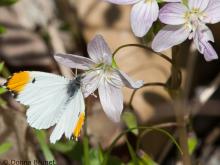
Species Types
Scientific Name
Anthocharis midea
Description
Falcate orangetip males are unmistakable with their small size, white coloration, and orange wingtips. Look for them in open woodlands in April.
Media

Species Types
Scientific Name
Colias eurytheme
Description
One of the most common butterflies in Missouri, the orange sulphur often gathers in numbers in moist places.
Media

Species Types
Scientific Name
Lycaena hyllus (syn. Hyllolycaena hyllus; Lycaena thoe)
Description
The bronze copper occurs in localized colonies in throughout northern and western Missouri. Look for it May through October in wet, open, grassy areas.
Media
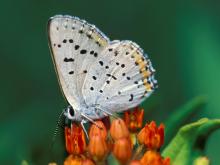
Species Types
Scientific Name
Lycaena dione (formerly Gaeides xanthoides dione)
Description
The gray copper is locally common in the western half of Missouri, where it flies in June and July. Look for it in moist, grassy, open areas during those months.
Media
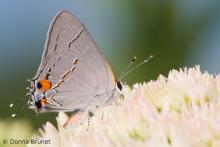
Species Types
Scientific Name
Strymon melinus
Description
The gray hairstreak, a small gray butterfly, is widespread throughout the United States. In Missouri, there are three or more broods each year.
See Also


Media

Species Types
Scientific Name
About 1,500 species in North America north of Mexico
Description
Adult caddisflies are mothlike. Their larvae are aquatic and build portable, protective cases out of local materials, including grains of sand, bits of leaves and twigs, and other debris.
Media

Species Types
Scientific Name
Corydalus cornutus
Description
Adult eastern dobsonflies are huge and mothlike, with large wings and a weak, fluttery flight. The fiercely predaceous aquatic larvae, called hellgrammites, are well-known to anglers, who often use them as bait.
About Butterflies and Moths in Missouri
Butterflies, skippers, and moths belong to an insect order called the Lepidoptera — the "scale-winged" insects. These living jewels have tiny, overlapping scales that cover their wings like shingles. The scales, whether muted or colorful, seem dusty if they rub off on your fingers. Many butterflies and moths are associated with particular types of food plants, which their caterpillars must eat in order to survive.





















